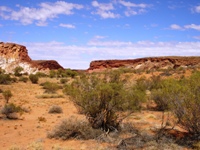Australia So Much to See


South of Alice Springs 2008 with visits to Owen Springs Reserve and Rainbow Valley Conservation Reserve.
The Bronco Yard was used for branding young cattle. After mustering, a horseman would rope the unbranded calf, bring it to the
branding platform, where it was roped down and branded. The whole process could take less than a minute.
The method
of secure the strained wire was unusual. The wire was secured around metal pins, leaving the post looking like it is covered
in hair curlers. Posts were made from mulga timber.
The red sandstone is the toughest rock as it has a relatively high content of iron and silica. The fallen dark brown blocks
have the most iron of all and once formed the capping.
Near the homestead ruins are the remnants of an old cattle yard. This is the oldest known ruin on the reserve. Many of
the posts have rotted away or remain as only a fraction of size they were before. Rings of wired around them show the size the
posts used to be.
The four wheel drive track traverses what was once a 1780 square kilometre cattle station. The
The
historic track through the station follows the route taken by John McDouall Stuart on his explorations between 1860 and 1862, which
opened up
Stuart, William Kekwick and Benjamin Head were the first caucasians
to travel through this country. On 11 April 1860, while making their way northwards along the
Even before the Line was completed in August 1872, cattleman William Gilbert was on his
way from
There are ruins of a station homestead complex near Lawrence Gorge, where the
Gilbert's original homestead buildings were made of timber and had thatched roofs.
It is thought that these stone
buildings were built during soon after Thomas Elder acquired the station in 1886. Some restoration work has taken place
on these ruins since our visit and I consider the white rendering has spoilt the appeal of these ruins as we saw them.
They
were used until the 1950s when a new homestead was built further upstream, which is now the Ranger Station.
Both Sidney Kidman
and Thomas Elder have owned station during the late 1800s. Elder at one stage attempted to breed horses for the Indian Army.
We exited the
The track through Lawrence Gorge follows along the river bed and can be quite sandy; this part the drive requires a four wheel drive vehicle. Camping is permitted along this section of the river and at a waterhole which we did not visit.
The strength of the different layers can be seen at nearby Mushroom Rock, which has broken down on the right side, with the undermining
very evident on the left side. Due to loose sand, there is a boardwalk to Mushroom Rock.
The colours of
Looking beyond the main ridge is a ridge known as Ewerre, still holding much of the dark capping.
The white zone has had the iron and silica leached out, and is very soft and fragile. As this layer erodes, the capping becomes
undermined and collapses, often falling off in large blocks.
Fairy Martin nests cling to the overhang of Mushroom Rock.
The fragile sandstone is crumbling into the claypan, taking colour from the rocks and leaving a pink surface across the claypan .

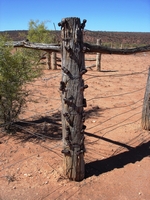
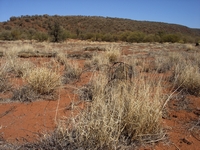
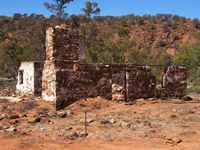
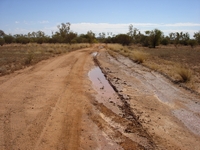
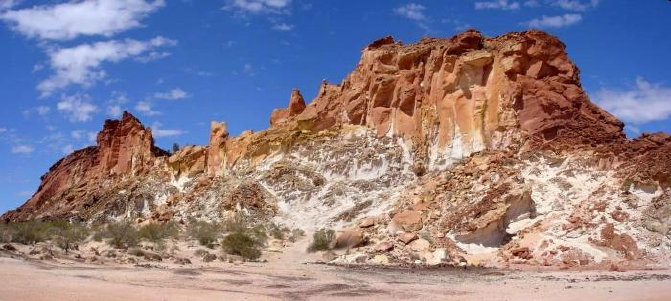
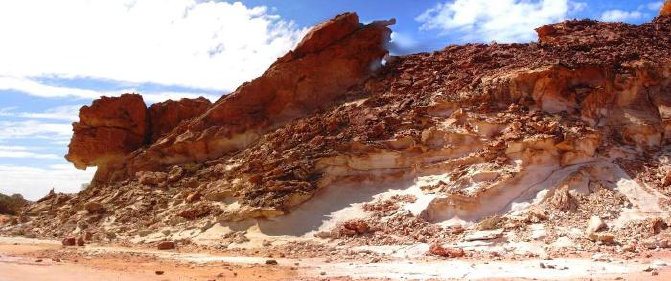
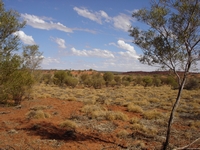
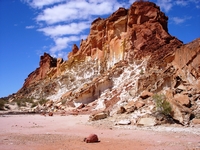
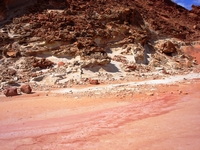
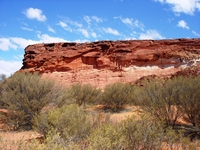
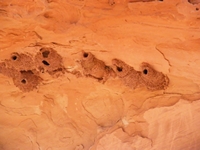
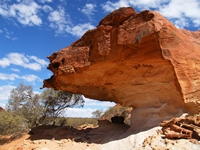
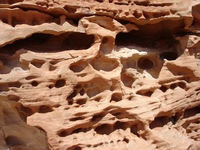
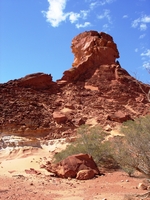
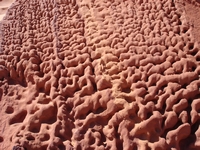
Along the 22 kilometre track to the
We did not see
We were privileged to meet and talk to Ricky Orr, a tour guide with Aboriginal heritage. After becoming aware of the Aboriginal
artefacts and petroglyphs in the Conservation Reserve, he established # guided tours to Rainbow Valley from Alice Springs, where participants
are given billy tea during the afternoon and treated to champagne and a light meal while viewing the ridge at sunset following being
shown the artefacts and petroglyphs not seen by most visitors to the Reserve. He is also teaching young Aborigines about their
culture.
Textured rock seen on the other side of the main coloured ridge.
